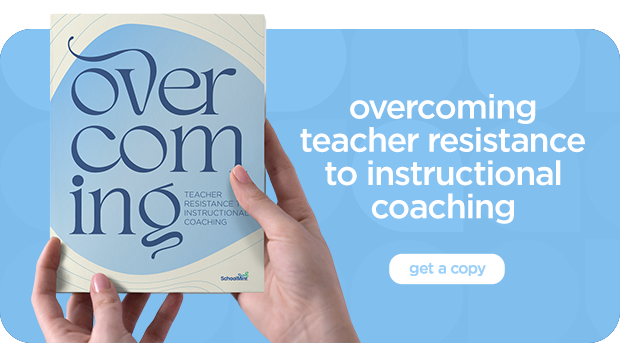Teacher Coaching with SchoolMint Grow: 12 Insights from Shanda Gentry
Shanda Gentry of Arthur Ashe Charter discusses how SchoolMint Grow eases teacher coaching — leading to success for students, teachers, and coaches alike.
At Arthur Ashe Charter School, feedback and growth are part of the school’s DNA. The school is located in New Orleans, Louisiana, as part of the FirstLine Schools public school network, where School Director Shanda Gentry is known for her forward-thinking, feedback-driven approach to leadership.
This is an approach that’s served her well as — throughout her tenure at Arthur Ashe — she’s seen incredible results with improving teacher efficacy and student outcomes through the teacher coaching platform SchoolMint Grow. So of course we wanted to learn how she does it!
We had the chance to sit down with Shanda and ask her a few questions about Arthur Ashe Charter School and how she uses SchoolMint Grow to coach everyone toward success — leaders, teachers, and students alike.
Note: you can also head over to our YouTube channel and view each interview question individually.
Table of Contents
1. What was teacher coaching like before SchoolMint Grow?
2. Why did you choose SchoolMint Grow?
3. What are the different ways you use SchoolMint Grow?
4. How has the way you use SchoolMint Grow changed over the years?
5. What is your process for teacher coaching?
6. How valuable is regular feedback?
7. How does SchoolMint Grow impact teacher efficacy?
8. How does SchoolMint Grow impact student outcomes?
9. What would you tell someone who is unsure about using SchoolMint Grow?
10. How do you approach teachers who are resistant to coaching?
11. How has SchoolMint Grow simplified and organized teacher coaching at your school?
12. What is the key to successful implementation of SchoolMint Grow?
SchoolMint: What was teacher coaching like before SchoolMint Grow?
Shanda Gentry: Before SchoolMint Grow, the way I managed teacher feedback was through lots of spreadsheets. I would have spreadsheets and reply-all emails to kind of have a place to capture all this ongoing feedback I had for teachers.
Then, when I went on to mentor other leaders, the spreadsheet was my way of seeing how often teachers were getting feedback. It was a lot of paperwork and work and tracking and making sure things were in place.

SM: Why did you choose SchoolMint Grow?
SG: SchoolMint Grow has this reputation in our city of being a systematic warehouse of teacher feedback.
Regardless of what network I joined, Grow is normally at the center of it. I think that speaks to the ease of use, the systematic approach, and the ability to make it custom to what our needs are. Those are things that make Grow something we want to use year after year.
SM: What are the different ways you use SchoolMint Grow?
SG: We use SchoolMint Grow in two ways. One is just teacher coaching and development, and the other way is through evaluation.
For us, or at least for me, a lot of times the coaching or evaluation rubric is also embedded in my coaching feedback. I make sure that whatever the rubric role is that I’m coaching a teacher on at that time that’s also embedded in their coaching feedback. In terms of evaluation, we go through the entire rubric during that evaluation.
Another thing I love about our school and the way we use [SchoolMint Grow] is teachers get the opportunity to do a self-reflection.
Teachers go in, they see their evaluation, they evaluate themselves first, and I, as a leader, go in and evaluate. Then, when we’re sitting in our meeting, we’re both pulling up like, “Here’s what you said, here’s what I say, here’s where we landed.”
It gives a teacher input into their evaluation and their development.
SM: How has the way you use SchoolMint Grow changed over the years?
SG: So when I started using SchoolMint Grow many, many years ago, I was a director of curriculum instruction, and my main job and focus was to coach pre-k through second-grade teachers.
Initially, I used it primarily just to do quick feedback, to give teachers an opportunity to see what I was thinking. Over the years, as my experience has changed and my roles have changed, I am now in a place where I use Grow in a very different way.
Some of the ways I use Grow now is not only to give quick feedback but to give feedback that is embedded in our rubric.
I also coach leaders now, and so some of the things I do as a leader coach is I pull up reports. I want to see are my leaders actually getting in classrooms? How often are they getting in classrooms? What are the types of feedback they’re giving?
I analyze action steps, I analyze data meetings, and all that is now at my fingertips. I’m at a place now that I can put a recurring meeting and it hits my Google Calendar. As somebody who struggles sometimes with staying organized, Grow helps me to stay on point in terms of those weekly meetings.
SM: What is your process for teacher coaching?
SG: When I am coaching teachers, before I walk into an actual coaching session with a leader, I do action-step analysis. Part of the reason I do action-step analysis is because I’m looking for a couple things:
- One, is the feedback (or the action step) relevant to where the teacher is?
- Two, is it bite-sized — like is this something they can do really quickly?
- And three, is it time-bound?
So is it relevant, is it bite-sized, is it time-bound?
I then take that action step and go to — let’s say I walk through with a leader — to see like all right, if we’re going to this classroom together and we’re observing, does this action step make sense? Is it something teachers can do right away?
So action-step analysis really allows me to fine-tune leaders’ ability to coach teachers.
SM: How valuable is regular feedback?
SG: As a school leader, particularly as a school director, one of the things we talk about a lot here at Ashe is feedback is a gift. Feedback is something that is given to everybody in the building, including myself.
We talk about how the leaders receive feedback, how the teachers receive back, even students! How can you get better if no one is telling you how to improve?
So for us, it’s not a matter of if I’m going to get feedback — it’s what is the feedback? How can I improve?
One of the things we talk about a lot here at Ashe is feedback is a gift.

Shanda Gentry
School Director
I think, over the years, because we are so focused on feedback as a way to increase student outcomes, when we go into classrooms now, teachers are texting us right away like, “What did you see? How can I fix it?” And a lot of that has to do with this culture feedback we’ve created.
Because of that, we see a pretty high retention rate amongst our staff. On average each year, we retain about 85% of our staff, and a lot of the feedback we get is about the level of support they get and the fact they appreciate that so many of our leaders are also instructional leaders and are able to go in and coach content.
I started off as a kindergarten teacher, and so I feel like if you can teach kindergarten, you can do anything. I make it my personal mission to learn every standard and content as much as I can so when I go into classrooms and I’m coaching teachers, I know what I’m saying.
I feel confident in what I’m saying, and it really does make a difference.
SM: How does SchoolMint Grow impact teacher efficacy?
SG: I think the biggest thing SchoolMint Grow does for teachers in terms of efficacy is it’s consistent and predictable. I like the fact it’s also customizable.
For us, for instance, in Grow our program shows our teachers our rubric, and so teachers are able to get feedback based on that rubric. When we come to those mid-year evaluations, this isn’t the first time they hear the rubric language. They’ve seen it all throughout the year because it’s embedded in our growth feedback.
SM: How does SchoolMint Grow impact student outcomes?
SG: SchoolMint Grow has helped us improve student outcomes in a sense that we’re able to really pinpoint and target feedback.
The thing I love most about Grow is the hashtags and being able to hashtag an observation so that I can later go back as school director and see how often are teachers in my building getting feedback from coaches on essential content and what’s the type of feedback they’re getting.
That allows me to not only develop leaders but also develop teachers, which ultimately leads to student outcomes.
SM: What would you tell someone who is unsure about using SchoolMint Grow?
SG: For anyone who’s unsure about using SchoolMint Grow, especially if you’re a teacher coach or a leader-slash-teacher coach like myself, Grow really organizes life for you in terms of coaching, and it saves a lot of time. I use it not only to give feedback to teachers but also to give feedback to leaders.
Just this morning, I was writing a report on how often our leaders get into certain classrooms and what are the action steps are being given. To be able to run those reports really, really quickly in one place saves me a lot of time — as opposed to my old method of spreadsheets and emails.
So if I were a leader thinking about a system that not only I can get into but teachers can get into, SchoolMint Grow would be the place. Because on the other side of that, teachers also get to go back and see what feedback they’ve gotten over time and reply to feedback sometimes.
I think it’s a really good platform to use if you’re trying to find a more systematic way to really improve not only teacher coaching but also student outcomes.
SM: How do you approach teachers who are resistant to coaching?
SG: Teachers who are resistant to coaching, a lot of times I find that really lies in mistrust or lack of a relationship. One of the initial ways we address it is simply by building a relationship and figuring out what is it that’s holding you back from receiving this feedback.
The other part is making sure we really, really name when feedback is given to us as leaders. Quite often we meet every week. We have whole-school huddles, so quite often if I’m giving feedback, I’ll say, “Hey, based on your feedback, here’s a shift I’m making.”
We really try to normalize feedback so much so that even our mentor teachers are giving feedback to each other, and at our grade-level meetings, we think about feedback. So for teachers who are resistant initially, it’s a lot of relationship-building, and then from there is also this whole culture of feedback. You just can’t run away from it.
If you’re still resistant, to be quite honest, those end up being teachers we don’t retain over the years, because my thing is everybody can learn something from somebody, and if you’re in a place where you don’t feel like you can learn, then the school isn’t the right place for you.
SM: How has SchoolMint Grow simplified and organized teacher coaching at your school?
SG: One of the ways SchoolMint Grow has helped us become more organized is simply in having our teacher rubric embedded. As we’re getting ready for data meetings or coaching meetings, we can actually pull up the rubric in Grow versus having to get the book and see what the language is. It makes it easier to copy and paste.
The other part is it really prompts us to think deeply about the rubrics and the current way we use it.
Inside the rubric itself, there are also prompts, so if I’m a new leader and I’m just learning how to do teacher coaching, the rubric is there. The questions are there.
It really helps them to think through things — like what are the key points of this observation you want to hear? What are the key points of the data meeting you really want to hit? — without having to scramble and look for books.
SM: What is the key to successful implementation of SchoolMint Grow?
SG: I think the biggest key to success with SchoolMint Grow is consistency.
One of the big things we do each year here is we go over with teachers and leaders like here is what Grow looks like on your side of the fence, here is how often we use it, and my rule right now — at least amongst my leaders — is if it’s not in Grow, it didn’t happen.
So there’s that expectation we’re putting feedback in Grow every time we’re in a classroom. There’s also expectations for teachers that hey, if leaders left my room, within 24 hours (probably end of the day), I’m going to see some feedback in Grow.
So I think that the biggest thing in terms of implementation is one, being consistent; two, teaching all the stakeholders how to use it; and three, trying to start really, really simple and then moving your way through it.
Share this
You May Also Like
These Related Stories

Arthur Ashe Charter School: Improving Student Outcomes Through Teacher Coaching

Using SchoolMint Grow for Teacher Coaching in Your School




